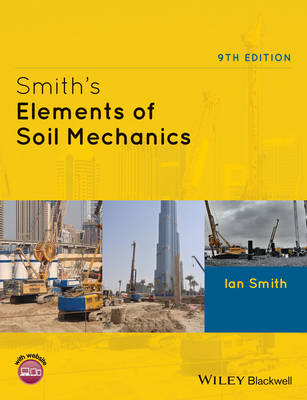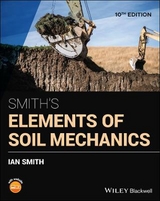
Smith′s Elements of Soil Mechanics
Wiley-Blackwell (Verlag)
978-0-470-67339-3 (ISBN)
- Titel ist leider vergriffen;
keine Neuauflage - Artikel merken
The 9th edition maintains the content on all soil mechanics subject areas - groundwater flow, soil physical properties, stresses, shear strength, consolidation and settlement, slope stability, retaining walls, shallow and deep foundations, highways, site investigation - but has been expanded to include a detailed explanation of how to use Eurocode 7 for geotechnical design. The key change in this new edition is the expansion of the content covering Geotechnical Design to Eurocode 7. Redundant material relating to the now defunct British Standards - no longer referred to in degree teaching - has been removed. Building on the success of the earlier editions, this 9th edition of Smith s Elements of Soil Mechanics brings additional material on geotechnical design to Eurocode 7 in an understandable format. Many worked examples are included to illustrate the processes for performing design to this European standard. Significant updates throughout the book have been made to reflect other developments in procedures and practices in the construction and site investigation industries. More worked examples and many new figures have been provided throughout.
The illustrations have been improved and the new design and layout of the pages give a lift. * unique content to illustrate the use of Eurocode 7 with essential guidance on how to use the now fully published code * clear content and well-organised structure * takes complicated theories and processes and presents them in easy-to-understand formats * book's website offers examples and downloads to further understanding of the use of Eurocode 7 www.wiley.com/go/smith/soil
Ian Smith had several years practical experience of site investigation and geotechnical consultancy before becoming a lecturer in Geotechnical Engineering at Edinburgh Napier University. He is now Head of the School of Engineering and the Built Environment. Widely recognised as an authority on the use of Eurocode 7, he has delivered keynote presentations and CPD courses on geotechnical design to Eurocode 7 in several countries throughout the world.
About the Author ix Preface x Notation Index xi About the Companion Website xvi 1 Classification and Physical Properties of Soils 1 1.1 Agricultural and engineering soil 1 1.2 Engineering definitions 2 1.3 Clay soils 4 1.4 Field identification of soils 5 1.5 Laboratory classification of soils 6 1.6 Activity of a clay 14 1.7 Soil classification and description 14 1.8 Soil properties 21 Exercises 30 2 Permeability and Flow of Water in Soils 33 2.1 Subsurface water 33 2.2 Flow of water through soils 35 2.3 Darcy s law of saturated flow 36 2.4 Coefficient of permeability, k 36 2.5 Determination of permeability in the laboratory 36 2.6 Determination of permeability in the field 40 2.7 Approximation of coefficient of permeability 42 2.8 General differential equation of flow 42 2.9 Potential and stream functions 44 2.10 Flow nets 45 2.11 Critical flow conditions 49 2.12 Design of soil filters 51 2.13 Capillarity and unsaturated soils 54 2.14 Earth dams 59 2.15 Seepage through non-uniform soil deposits 62 Exercises 71 3 Total and Effective Stress 74 3.1 State of stress in a soil mass 74 3.2 Total stress 75 3.3 Pore pressure 76 3.4 Effective stress 77 3.5 Stresses induced by applied loads 80 Exercises 89 4 Shear Strength of Soils 91 4.1 Friction 91 4.2 Complex stress 91 4.3 The Mohr circle diagram 92 4.4 Cohesion 96 4.5 Coulomb s law of soil shear strength 96 4.6 Modified Coulomb s law 98 4.7 The Mohr Coulomb yield theory 98 4.8 Determination of the shear strength parameters 99 4.9 Determination of the shear strength parameters from triaxial testing 106 4.10 The pore pressure coefficients A and B 112 4.11 The triaxial extension test 118 4.12 Behaviour of soils under shear 119 4.13 Operative strengths of soils 122 4.14 The critical state 124 4.15 Sensitivity of clays 129 4.16 Residual strength of soil 130 Exercises 133 5 Eurocode 7 136 5.1 Introduction to the Structural Eurocodes 136 5.2 Introduction to Eurocode 7 138 5.3 Using Eurocode 7: basis of geotechnical design 139 5.4 Geotechnical design by calculation 139 5.5 Ultimate limit states 145 5.6 The EQU limit state 147 5.7 The GEO limit state and design approaches 150 5.8 Serviceability limit states 155 5.9 Geotechnical design report 155 6 Site Investigation 156 6.1 EN 1997-2:2007 Ground investigation and testing 156 6.2 Planning of ground investigations 157 6.3 Site exploration methods 160 6.4 Soil and rock sampling 164 6.5 Groundwater measurements 170 6.6 Field tests in soil and rock 172 6.7 Geotechnical reports 179 7 Lateral Earth Pressure 183 7.1 Earth pressure at rest 183 7.2 Active and passive earth pressure 183 7.3 Rankine s theory: granular soils, active earth pressure 185 7.4 Rankine s theory: granular soils, passive earth pressure 190 7.5 Rankine s theory: cohesive soils 191 7.6 Coulomb s wedge theory: active earth pressure 195 7.7 Coulomb s wedge theory: passive earth pressure 202 7.8 Surcharges 205 7.9 Choice of method for determination of active pressure 210 7.10 Backfill material 210 7.11 Influence of wall yield on design 215 7.12 Design parameters for different soil types 216 Exercises 219 8 Retaining Structures 221 8.1 Main types of retaining structures 221 8.2 Gravity walls 221 8.3 Embedded walls 224 8.4 Failure modes of retaining structures 225 8.5 Design of gravity retaining walls 226 8.6 Design of sheet pile walls 236 8.7 Braced excavations 248 8.8 Reinforced soil 250 8.9 Soil nailing 251 Exercises 252 9 Bearing Capacity and Shallow Foundations 255 9.1 Bearing capacity terms 255 9.2 Types of foundation 255 9.3 Ultimate bearing capacity of a foundation 256 9.4 Determination of the safe bearing capacity 263 9.5 The effect of groundwater on bearing capacity 264 9.6 Developments in bearing capacity equations 265 9.7 Designing spread foundations to Eurocode 7 269 9.8 Non-homogeneous soil conditions 284 9.9 Estimates of bearing capacity from in situ testing 285 Exercises 288 10 Pile Foundations 290 10.1 Introduction 290 10.2 Classification of piles 290 10.3 Method of installation 291 10.4 Pile load testing 294 10.5 Determination of the bearing capacity of a pile 296 10.6 Designing pile foundations to Eurocode 7 303 10.7 Pile groups 311 Exercises 313 11 Foundation Settlement and Soil Compression 315 11.1 Settlement of a foundation 315 11.2 Immediate settlement 316 11.3 Consolidation settlement 325 11.4 Application of consolidation test results 335 11.5 General consolidation 336 11.6 Eurocode 7 serviceability limit state 343 11.7 Isotropic consolidation 344 11.8 Two-dimensional stress paths 346 Exercises 352 12 Rate of Foundation Settlement 355 12.1 Analogy of consolidation settlement 355 12.2 Distribution of the initial excess pore pressure, ui 355 12.3 Terzaghi s theory of consolidation 355 12.4 Average degree of consolidation 359 12.5 Drainage path length 359 12.6 Determination of the coefficient of consolidation, cv, from the consolidation test 360 12.7 Determination of the permeability coefficient from the consolidation test 362 12.8 Determination of the consolidation coefficient from the triaxial test 362 12.9 The model law of consolidation 365 12.10 Consolidation during construction 366 12.11 Consolidation by drainage in two and three dimensions 369 12.12 Numerical determination of consolidation rates 369 12.13 Construction pore pressures in an earth dam 374 12.14 Numerical solutions for two- and three-dimensional consolidation 376 12.15 Sand drains 378 Exercises 384 13 Stability of Slopes 386 13.1 Planar failures 386 13.2 Rotational failures 390 13.3 Slope stability design charts 408 13.4 Wedge failure 414 13.5 Slope stability analysis to Eurocode 7 416 Exercises 421 14 Compaction and Soil Mechanics Aspects of Highway Design 432 14.1 Field compaction of soils 432 14.2 Laboratory compaction of soils 434 14.3 Specification of the field compacted density 441 14.4 Field measurement tests 442 14.5 Highway design 446 Exercises 457 References 460 Index 466
| Erscheint lt. Verlag | 5.9.2014 |
|---|---|
| Verlagsort | Hoboken |
| Sprache | englisch |
| Maße | 192 x 238 mm |
| Gewicht | 1020 g |
| Themenwelt | Technik ► Bauwesen |
| ISBN-10 | 0-470-67339-7 / 0470673397 |
| ISBN-13 | 978-0-470-67339-3 / 9780470673393 |
| Zustand | Neuware |
| Haben Sie eine Frage zum Produkt? |
aus dem Bereich



